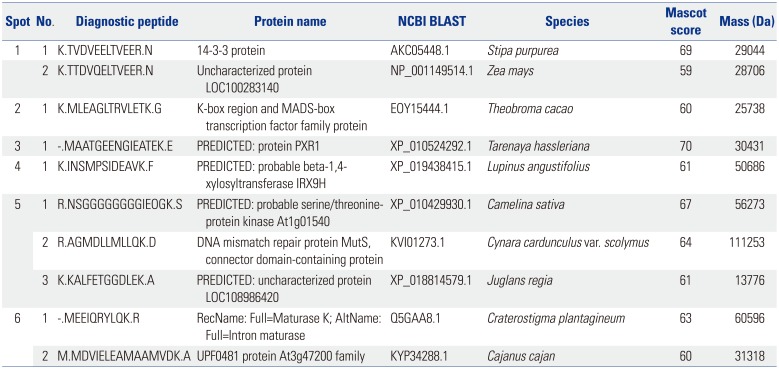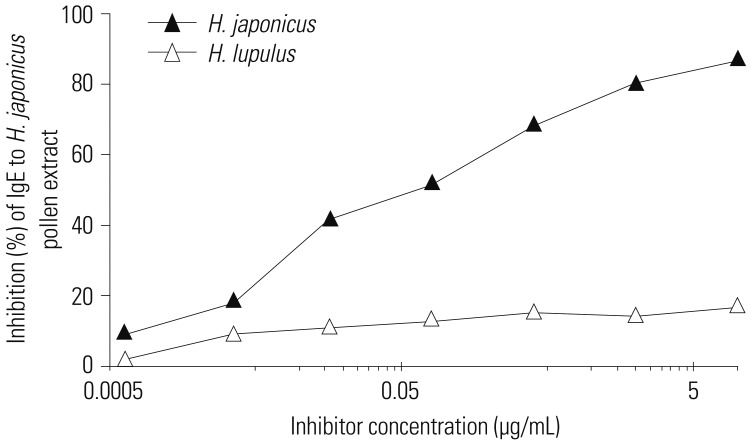1. Park HS, Nahm DH, Suh CH, Lee SM, Choi SY, Jung KS, et al. Evidence of Hop Japanese pollinosis in Korea: IgE sensitization and identification of allergenic components. J Allergy Clin Immunol. 1997; 100:475–479. PMID:
9338540.

2. Park HJ, Lee JH, Park KH, Kim KR, Han MJ, Choe H, et al. A six-year study on the changes in airborne pollen counts and skin positivity rates in Korea: 2008–2013. Yonsei Med J. 2016; 57:714–720. PMID:
26996572.

3. Wang XY, Ma TT, Wang XY, Zhuang Y, Wang XD, Ning HY, et al. Prevalence of pollen-induced allergic rhinitis with high pollen exposure in grasslands of northern China. Allergy. 2018; 73:1232–1243. PMID:
29322523.

4. Cui L, Yin J. Association of serum specific IgE levels with asthma in autumn pollen-induced allergic rhinitis: a retrospective analysis. J Asthma. 2018; 4. 18. [Epub]. DOI:
10.1080/02770903.2018.1466316.

5. Jeong KY, Son M, Choi SY, Park KH, Park HJ, Hong CS, et al. Standardization of weed pollen extracts, Japanese hop and mugwort, in Korea. Yonsei Med J. 2016; 57:399–406. PMID:
26847293.

6. Codina R, Crenshaw RC, Lockey RF. Considerations about pollen used for the production of allergen extracts. J Allergy Clin Immunol Pract. 2015; 3:676–682. PMID:
26004305.

7. Esch RE. Allergen source materials and quality control of allergenic extracts. Methods. 1997; 13:2–13. PMID:
9281463.

8. Spiewak R, Gòra A, Dutkiewicz J. Work-related skin symptoms and type I allergy among eastern-Polish farmers growing hops and other crops. Ann Agric Environ Med. 2001; 8:51–56. PMID:
11426925.
9. Reeb-Whitaker CK, Bonauto DK. Respiratory disease associated with occupational inhalation to hop (
Humulus lupulus) during harvest and processing. Ann Allergy Asthma Immunol. 2014; 113:534–538. PMID:
25216973.
10. Jung CG, Yang EM, Lee JH, Kim HM, Park HS. Evaluation of the allergenic relationship between Humulus japonicus and Humulus lupulus pollen allergens. Allergy Asthma Respir Dis. 2017; 5:217–222.
11. Park JW, Ko SH, Kim CW, Jeoung BJ, Hong CS. Identification and characterization of the major allergen of the
Humulus japonicus pollen. Clin Exp Allergy. 1999; 29:1080–1086. PMID:
10457112.
12. Burastero SE. Pollen-cross allergenicity mediated by panallergens: a clue to the patho-genesis of multiple sensitizations. Inflamm Allergy Drug Targets. 2006; 5:203–209. PMID:
17168790.

13. Tao AL, He SH. Cloning, expression, and characterization of pollen allergens from
Humulus scandens (Lour) Merr and
Ambrosia artemisiifolia L. Acta Pharmacol Sin. 2005; 26:1225–1232. PMID:
16174439.
14. Jeong KY, Han IS, Choi SY, Lee JH, Lee JS, Hong CS, et al. Allergenicity of recombinant profilins from Japanese hop, Humulus japonicus. J Investig Allergol Clin Immunol. 2013; 23:345–350.
15. Hong Q, Zhou S, Zhao H, Peng J, Li Y, Shang Y, et al. Allergenicity of recombinant
Humulus japonicus pollen allergen 1 after combined exposure to ozone and nitrogen dioxide. Environ Pollut. 2018; 234:707–715. PMID:
29241157.







 PDF
PDF ePub
ePub Citation
Citation Print
Print





 XML Download
XML Download